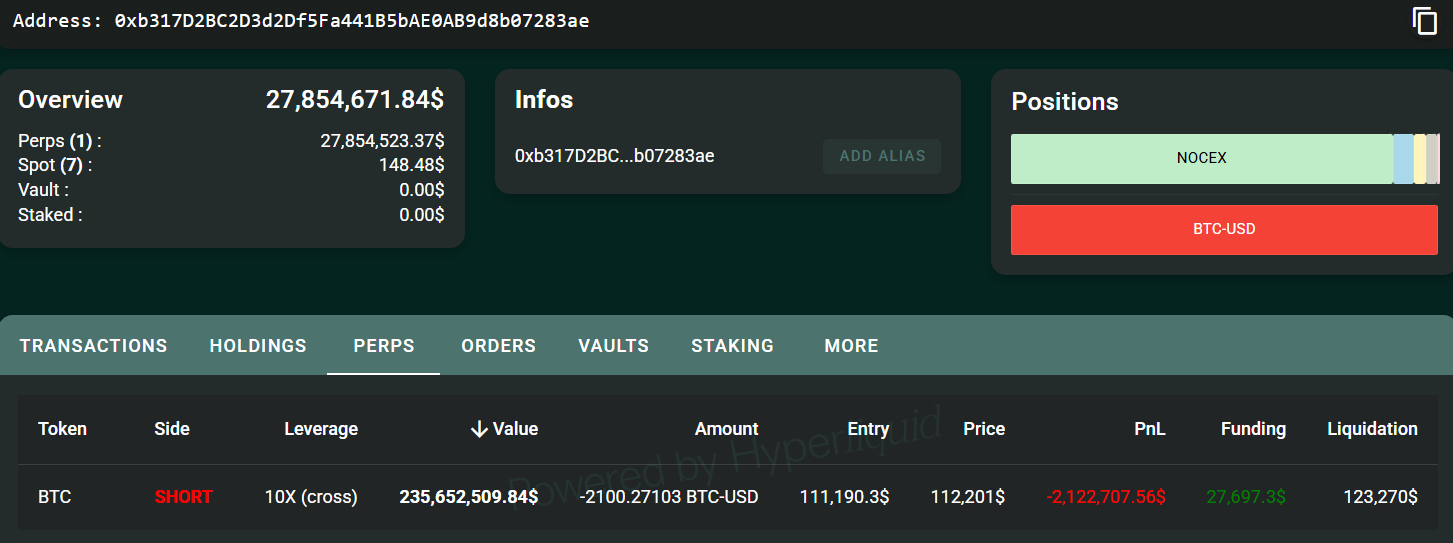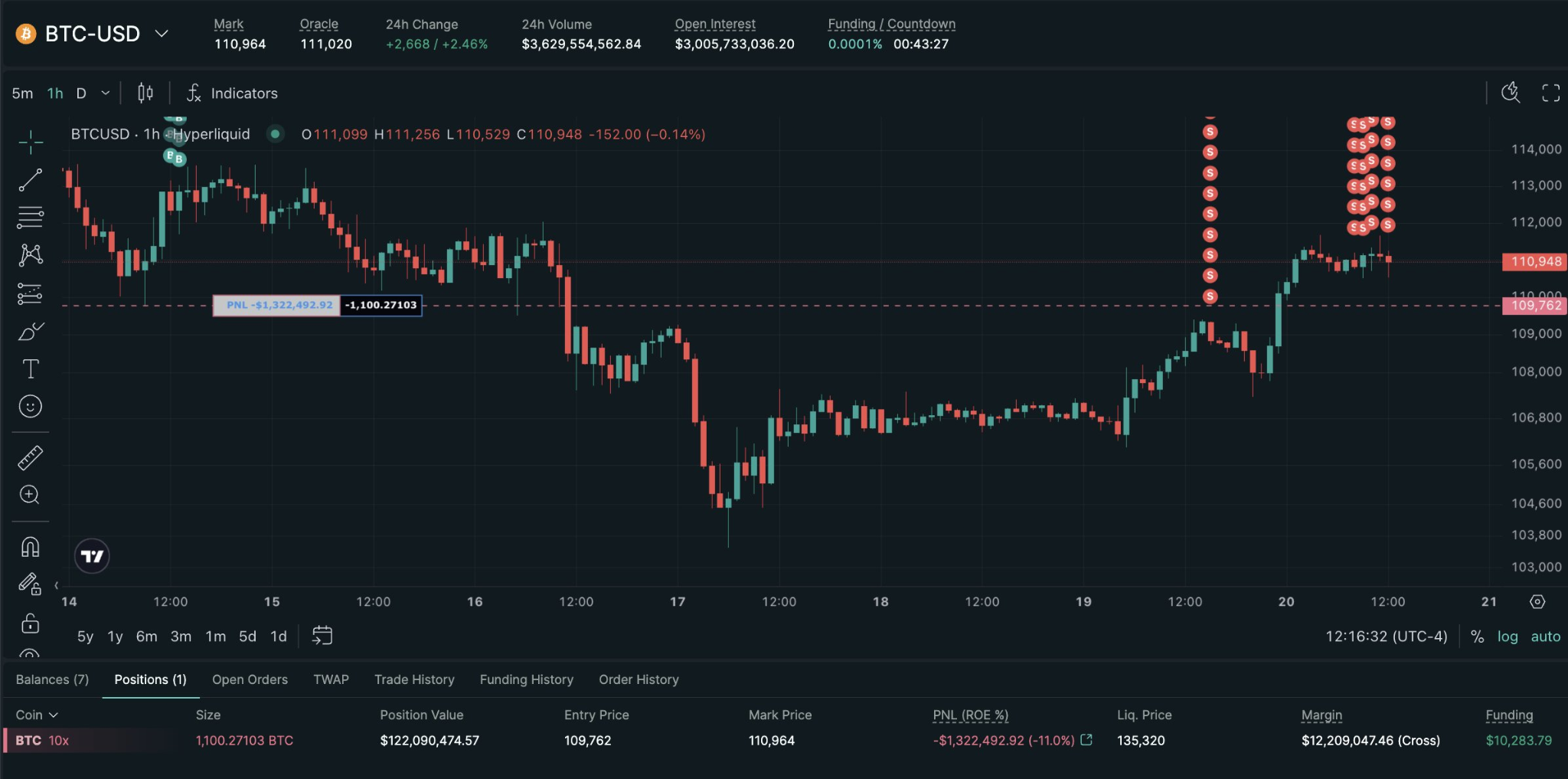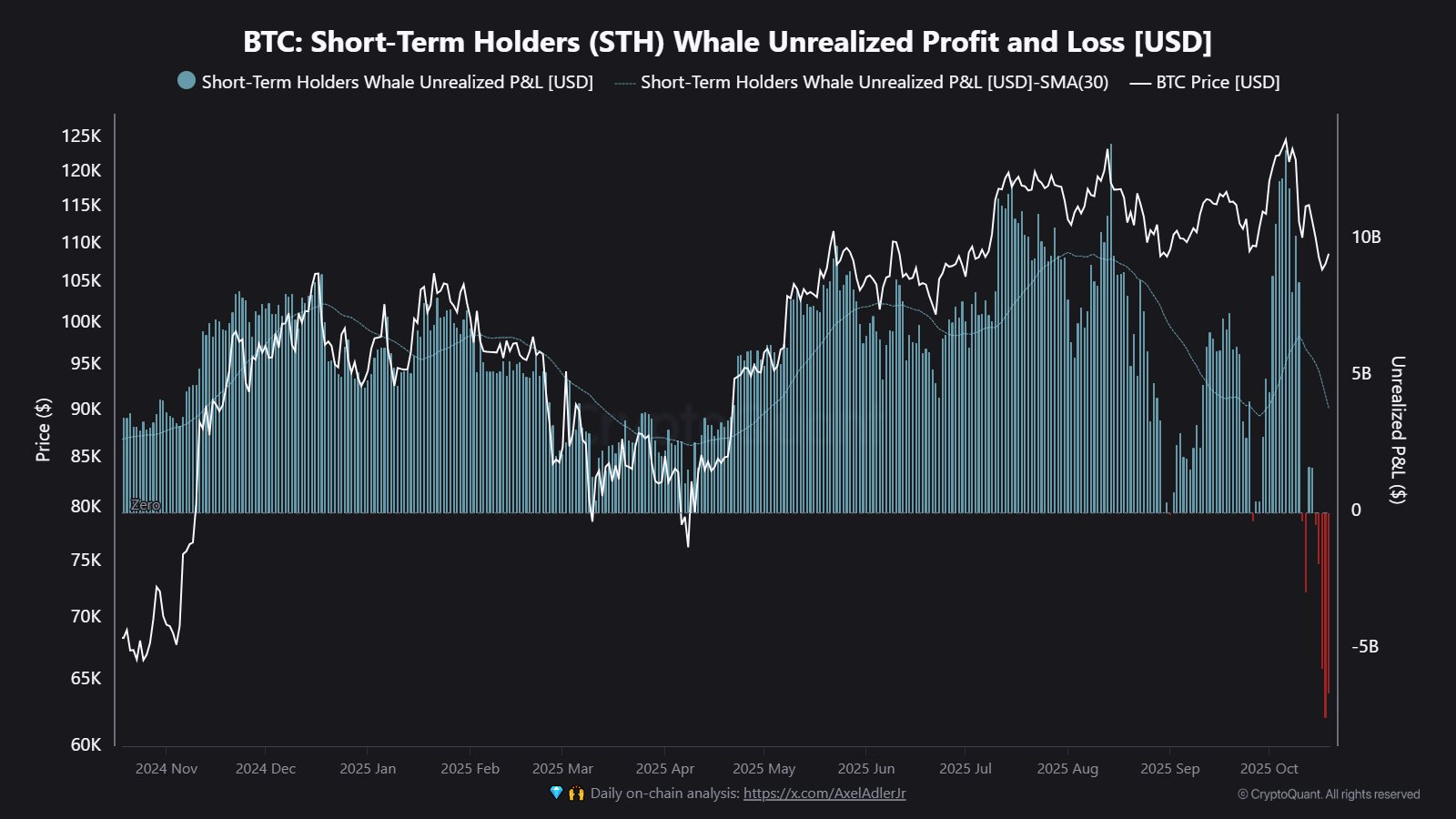The $11 billion Bitcoin whale recently opened a $235 million leveraged short position on Bitcoin, betting on further price declines amid market volatility from tariffs and government shutdown concerns. This follows a $200 million profit from last week’s crash, highlighting strategic hedging by major investors.
-
$235 million short bet: The whale entered a 10-times leveraged position on Bitcoin at $111,190, facing potential liquidation above $112,368.
-
Previous $200 million profit from a similar short during the market crash to $100,000, demonstrating effective timing in volatile conditions.
-
$11 billion portfolio includes recent $540 million Bitcoin transfers to exchanges like Coinbase, signaling ongoing portfolio adjustments with 45% unrealized whale losses at $6.95 billion.
Discover how the $11 billion Bitcoin whale profits from crypto crashes with bold short positions. Stay ahead of market trends and learn hedging strategies in this volatile era. Read more now.
What is the Latest Short Position by the $11 Billion Bitcoin Whale?
The $11 billion Bitcoin whale has initiated a significant $235 million short position on Bitcoin using 10-times leverage, effectively wagering on a decline in the cryptocurrency’s price. This move, opened when Bitcoin traded at $111,190, reflects broader market caution driven by tariff uncertainties and the ongoing government shutdown. According to blockchain data from Hypurrscan, the position currently holds a $2.6 million unrealized loss, with liquidation risks if prices exceed $112,368.
This strategy builds on the whale’s recent success, where it profited approximately $200 million from a prior leveraged short during last week’s market downturn. Large investors like this whale, often referred to in crypto communities as entities holding substantial Bitcoin reserves, use such tactics to hedge against volatility. By borrowing capital to amplify positions, they can magnify gains but also face heightened risks of total loss.

Wallet ‘0xb317,’ short position. Source: Hypurrscan.io
In a recent update shared by blockchain data platform Arkham on X, the whale transferred $30 million to Hyperliquid to execute this new short, underscoring a pattern of aggressive positioning. Additionally, over the past week, the investor moved $540 million in Bitcoin to new wallets, including $220 million to Coinbase exchange wallets, potentially preparing for further trades or diversification.

Source: Arkham
Emerging two months ago, this whale previously rotated about $5 billion from Bitcoin to Ether, temporarily outpacing major corporate holders like Sharplink in ETH reserves. Analyst Willy Woo, an early Bitcoin adopter, has noted that large-scale sales from dormant whales contributed to August’s price limitations, emphasizing the influence of such entities on market dynamics.
How Are New Bitcoin Whales Handling Unrealized Losses After the Market Crash?
Newer Bitcoin whales are grappling with over $6.95 billion in cumulative unrealized losses following the recent crypto market crash that pushed Bitcoin below $113,000. Crypto analytics platform CryptoQuant reported on X that Bitcoin now trades under its average cost basis of around $113,000, marking the largest unrealized loss for this group since October 2023. This cohort represents about 45% of the total whale realized capital, highlighting the sector’s vulnerability to sharp corrections.

Source: CryptoQuant
Despite the downturn, experts view the four-day drop to $104,000 as a necessary correction that eliminated excess leverage and encouraged more prudent market behavior. Blockchain analytics firm Glassnode observed in their Tuesday report an increase in short-term Bitcoin holder supply, with speculative capital gaining a larger market share. This shift suggests a maturing investor base, where long-term holders are counterbalancing the actions of aggressive traders like the $11 billion whale.
“The whale who made $200 million shorting the Bitcoin crash to $100,000 has now moved $30 million to Hyperliquid and is shorting again,” stated Arkham in their analysis, pointing to continued bearish sentiment among top holders. Such moves by whales often signal broader trends, as their large positions can sway liquidity and price action. For instance, the transfer of substantial Bitcoin amounts to exchanges like Coinbase may indicate preparations for sales or swaps, adding to market uncertainty.
In the context of ongoing economic pressures, including tariff concerns and the government shutdown, these whale activities underscore the interconnectedness of traditional finance and crypto. While leveraged shorts offer high-reward opportunities, they demand precise timing, as evidenced by the current unrealized losses on this latest bet. Market participants are closely monitoring whether Bitcoin can rebound above key levels to avert further liquidations.
Frequently Asked Questions
What Profit Did the $11 Billion Bitcoin Whale Make from the Recent Crypto Crash?
The $11 billion Bitcoin whale realized about $200 million in profit from a leveraged short position during last week’s crypto market crash, when Bitcoin fell to $100,000. This gain came from strategically closing the position amid heightened volatility, showcasing the potential rewards of well-timed bearish trades in the Bitcoin market.
Why Is the Bitcoin Whale Betting on Further Downside in the Crypto Market?
The Bitcoin whale is betting on further downside due to concerns over tariffs and the ongoing government shutdown, which could exacerbate economic uncertainty and pressure cryptocurrency prices. With a new $235 million short on Bitcoin via 10-times leverage, this move aligns with hedging strategies used by large investors to protect against anticipated declines in the volatile crypto landscape.
Key Takeaways
- Leveraged Short Positions Amplify Risks and Rewards: The whale’s $235 million bet on Bitcoin decline uses 10-times leverage, potentially yielding high profits but risking full liquidation if prices rise above $112,368.
- Whale Movements Influence Market Sentiment: Transfers of $540 million in Bitcoin, including to Coinbase, signal portfolio adjustments that could precede larger sales or rotations into assets like Ether.
- New Whales Face Significant Losses: Over $6.95 billion in unrealized losses for recent entrants highlight the need for conservative strategies amid corrections that flush out leverage.
Conclusion
The $11 billion Bitcoin whale‘s latest short position and prior $200 million profit from the market crash illustrate the high-stakes nature of whale trading in the Bitcoin market. As newer whales contend with $6.95 billion in unrealized losses, the sector’s volatility persists, influenced by macroeconomic factors like tariffs and shutdowns. Investors should monitor these large-scale moves for insights into future trends, staying informed to navigate the evolving crypto landscape effectively.
